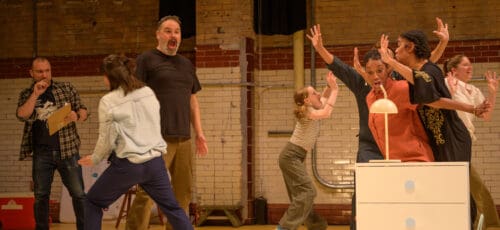A Watery, Sinking Future: Interview with Mary Mattingly, creator of WetLand

WetLand. Image by Mary Mattingly.
If you’ve ever wished you could live at the Fringe Festival, you should meet Mary Mattingly. The Presented Fringe artist will live on WetLand, a boat-based ecosystem moored on the Delaware River, for the entirety of the Festival. WetLand captures the uncertainties of city-based living in an age of global warming, and proposes a hopeful alternative. In addition to housing Mary and other artists, WetLand will also host concerts, workshops, skill shares, and a few performances by Neighborhood Fringe artists. WetLand will be free and open daily Aug 15–Sept 21.
FringeArts: Why is the title WetLand?
Mary Mattingly: I’m concerned about the slow erasure of wetlands around the world, as they are important ecosystems that breed aquatic and terrestrial life, protect the mainland from storms, and naturally clean the air and waterways. They are often drained for large building projects and result in areas that flood, destructing homes and infrastructure in a loss that is for some unrecoverable. The largest loss is ecosystem diversity, which has tremendous reverberating effects throughout the natural world, and in the end makes the planet a worse place for us all to live.
I wanted to bring more attention to the necessity of wetlands, and pair it with a sinking house to describe causation through a symbolic artwork. I was also thinking about the combination in a very literal way: wet and land, to describe a watery, sinking future.
FringeArts: What’s the process of creation in such a work?
Mary Mattingly: In this piece I began considering the natural zone between the river and urban space. In many cities, it’s a space that is either overlooked or that undergoes a process of quick development. It’s a place where we must consider nature, because we are so close to it and dependent on it. Reconnecting the water with a row house puts many of us in the place of the inhabitant.
I was spending a lot of time thinking about how we live in a social system that allows us an illusion of disconnect from nature. We expect our food to be in the grocery store, we are accustomed to clean water coming from the tap, but those are expectations most of the world doesn’t have, and they are things that we can’t always be dependent on. Marrying nature to the city directly describes these food, water, and energy systems we depend on.
FringeArts: How do habitat, water, and art connect for you?
Mary Mattingly: These things are all necessities for me, and I need one as much as the other. As artists we often work with our own needs, and sometimes those are universal. Water has always been a particular concern for me. I grew up in an area that continually flooded, and where the drinking water contained dangerously high levels of agricultural runoff, having long-term effects on the area. I watched bottled water become a popular commodity, and learned about Bechtel and the World Bank’s privatization of water in Bolivia, which was eventually reversed through long protests.
FringeArts: Why is it important to live on WetLand?
Mary Mattingly: Living on WetLand is an essential part of an experiment that needs to be played out in real time. Like a form of performance art, it’s an exploration through endurance, and we also keep the living systems running. It’s an act of creating an ecosystem from which three people will eat, drink, shower, work, sleep, learn, and share.
FringeArts: How do you see this relationship between the solitary artist and the need to construct a community?
Mary Mattingly: Like many people, I thrive on both solitude and solidarity. I believe we need to make more time and physical spaces to be together, to strengthen the ties we have found in the virtual space and regain those that have been lost because of those separations. We need to make a better world to live in, and when we are confined to inside spaces it’s easy to forget about the larger world around us, and how something we do here affects someone across the world.
FringeArts: Why the clearly human-made aesthetic of WetLand?
Mary Mattingly: It’s important for me to distinguish this work from doing something in a “back to land” context. Many times people leave cities because they want to be closer to land, and because they can. But many people cannot. Leaving the city in most cases is a luxury that allows for a different perspective. I want to have more chances for some of that perspective here in our cities, and bringing nature and natural living systems to a city’s periphery is a way I’ve thought to do that.
Living in a city is such an asset. There are always people around we can turn to, learn from, and work with. I believe that our urban centers will need to be the future sites that produce our daily necessities (especially food, energy, and water) and we need to strengthen citywide projects that focus on that production, on small scales with our neighbors, and on larger scales with our entire city. When we are solely dependent on a large supply chains for our daily needs, then we are beholden to it and it’s virtually impossible to see the larger picture of how these systems exploit the environment and human labor.
Thank you, Mary.
WetLand event information available here. Events are free, but may require an RSVP. Tickets and more information about Fringe Festival shows here.
WetLand
Independence Seaport Museum Pier
211 S Columbus Boulevard (at Dock Street)
Aug 15–Sept 21, ongoing daily 10am–5pm


